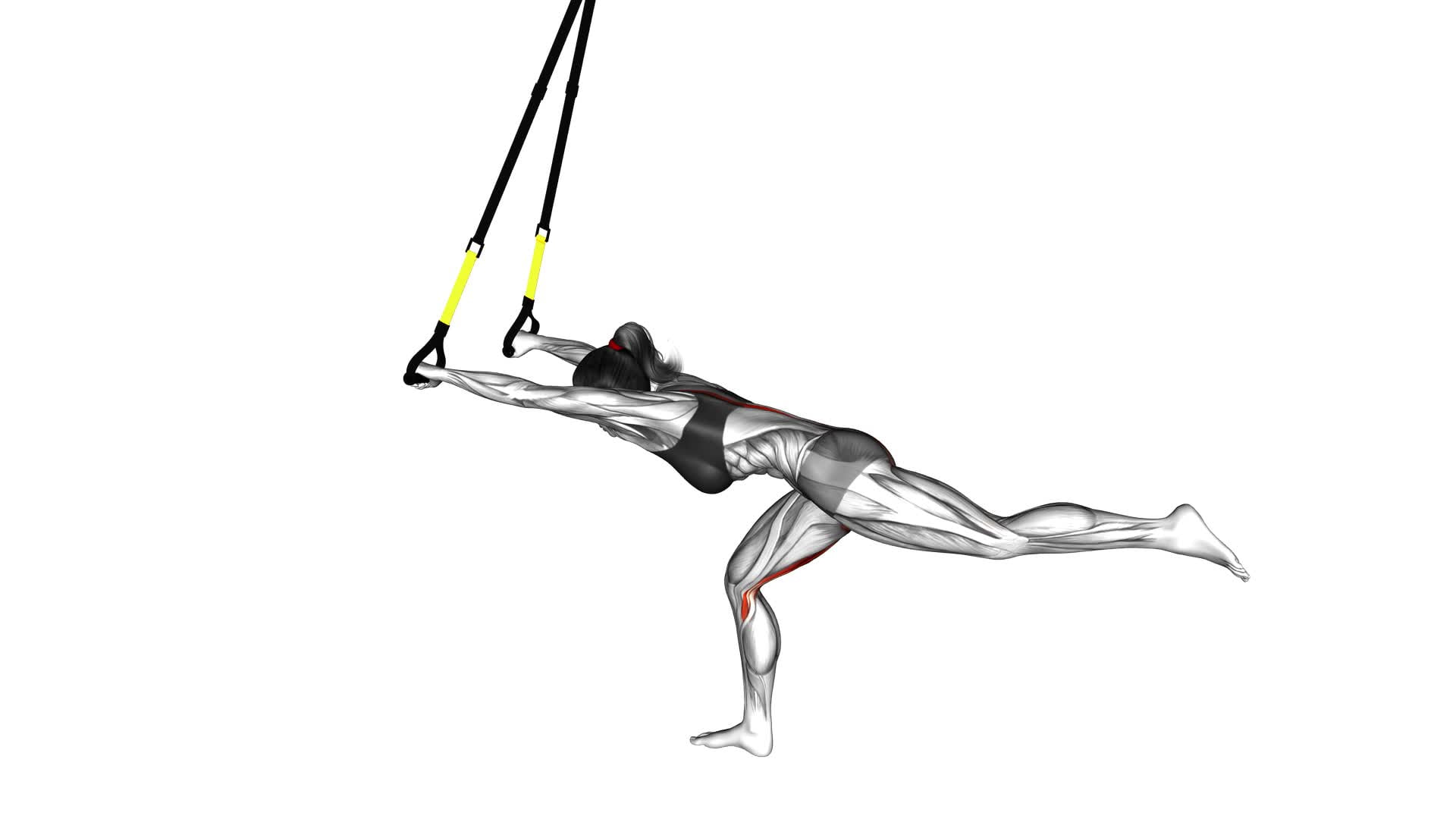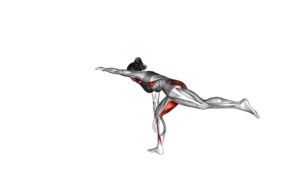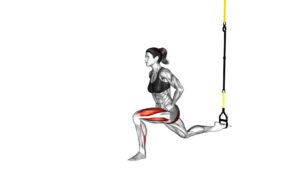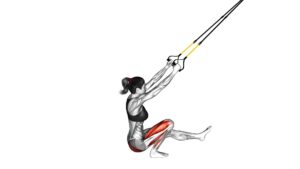Suspender Single Leg Deadlift (female) – Video Exercise Guide & Tips

Get ready to tone and strengthen your legs with the Suspender Single Leg Deadlift! This video exercise guide will show you the proper form and technique to maximize your results.
Watch This Exercise Video
Avoid common mistakes and learn variations to challenge yourself.
With these tips, you'll have a safe and effective workout.
So grab your suspenders and get ready to feel the burn!
Key Takeaways
- The Suspender Single Leg Deadlift helps build core strength, activate glutes, and improve balance and stability.
- Proper form and technique, such as maintaining correct hip hinge alignment and focusing on core stability, are crucial for performing the exercise effectively.
- Balancing on one leg and engaging muscles on one side at a time can improve stability and core strength.
- Common mistakes to avoid include incorrect hip alignment, improper weight distribution, and not starting with lighter weights or using resistance bands for support.
Benefits of the Suspender Single Leg Deadlift
You can experience various benefits from performing the Suspender Single Leg Deadlift. This exercise isn't only effective in building core strength and glute activation, but it also helps improve your balance and stability.
By engaging your core muscles throughout the exercise, the Suspender Single Leg Deadlift helps strengthen your entire midsection. Your abdominal muscles, obliques, and lower back all work together to maintain stability and control as you perform the movement. This not only helps develop a strong core, but it also improves your overall posture and reduces the risk of back pain.
Additionally, the single-leg aspect of this exercise targets your glutes, also known as your butt muscles. As you hinge forward and lift your leg behind you, the glutes are engaged to maintain balance and control. This results in not only a stronger, more toned booty, but also improved hip stability and better overall lower body strength.
To maximize the benefits of the Suspender Single Leg Deadlift, focus on maintaining proper form throughout the movement. Keep your core tight, hinge forward from your hips, and lift your leg behind you while keeping your back straight. Start with a lighter resistance band and gradually increase the difficulty as you become more comfortable and stronger.
Incorporating the Suspender Single Leg Deadlift into your workout routine will help you develop a stronger core, activate your glute muscles, and improve your balance and stability. Stay consistent with your training, and you'll soon reap the rewards of this challenging yet highly beneficial exercise.
Proper Form and Technique
To perform the Suspender Single Leg Deadlift with proper form and technique, there are three key points to focus on.
First, ensure your hip hinge alignment is correct, keeping your back straight and hinging at the hips.
Second, maintain core stability throughout the movement to protect your lower back and improve balance.
Lastly, remember to engage your stabilizing muscles and focus on balancing on one leg to maximize the benefits of this exercise.
Mastering these points will help you perform the exercise effectively and safely.
Hip Hinge Alignment
Maintain proper alignment of your hips during the Suspender Single Leg Deadlift exercise by focusing on the positioning of your hip hinge. This is crucial for correcting posture and strengthening your glutes effectively.
To ensure proper hip hinge alignment, start by standing tall with your feet hip-width apart and your core engaged. As you hinge forward from your hips, keep your back straight and your chest lifted. Avoid rounding your lower back or letting your shoulders slump forward.
Engage your glutes and hamstrings to control the movement as you lower the suspended leg towards the ground.
Core Stability Importance
Proper form and technique are essential for maintaining core stability during the Suspender Single Leg Deadlift exercise. To ensure that you maximize the benefits of this exercise and prevent any injuries, here are some important tips to keep in mind:
- Engage your core: Before you begin the movement, activate your core muscles by pulling your belly button towards your spine. This will help stabilize your torso throughout the exercise.
- Maintain a neutral spine: Keep your back straight and avoid rounding or arching during the movement. Imagine lengthening your spine as you hinge forward at the hips.
- Control the movement: Slowly lower your body down while maintaining balance on one leg. Focus on using your core muscles to control the descent and ascent, rather than relying on momentum.
- Breathe properly: Inhale as you lower your body and exhale as you return to the starting position. This will help you maintain proper form and stability.
By following these tips and incorporating core stability exercises into your regular core strength training routine, you'll develop a strong and stable core, which is vital for overall fitness and functional movement.
Now that you understand the importance of core stability, let's dive into the next section about balancing on one leg.
Balancing on One Leg
You should frequently practice balancing on one leg to improve your stability and strengthen your core muscles. Balancing on one leg is an effective exercise for enhancing your balance and developing stability. It's a form of balance training that challenges your body's ability to maintain equilibrium.
By performing unilateral exercises like balancing on one leg, you engage the muscles on one side of your body at a time, which helps to address any strength imbalances and improve overall stability. To perform this exercise, stand tall on one leg, keeping your core engaged and your body aligned. Focus on maintaining your balance for as long as you can, gradually increasing the duration over time.
Incorporating balancing exercises into your routine won't only enhance your stability but also contribute to better overall performance in various activities. So, start practicing and reap the benefits of improved balance and core strength.
Common Mistakes to Avoid
To perform the Suspender Single Leg Deadlift correctly, it's important to avoid common mistakes that can hinder your progress.
One common mistake is incorrect hip alignment, where your hips aren't properly squared towards the ground. This can lead to strain on the lower back and a less effective workout.
Another mistake to watch out for is improper weight distribution, where you may find yourself leaning too far forward or backward, throwing off your balance and potentially causing injury.
Incorrect Hip Alignment
Avoiding incorrect hip alignment is crucial for performing the Suspender Single Leg Deadlift exercise effectively. When your hips aren't properly aligned, you can put unnecessary strain on your lower back and increase the risk of injury. To ensure correct hip alignment, follow these tips:
- Maintain a neutral spine: Avoid rounding or arching your back during the exercise. Keep your spine straight and aligned with your hips.
- Engage your core: Activate your core muscles to stabilize your pelvis and maintain proper alignment throughout the movement.
- Keep your hips level: Prevent one hip from dipping lower than the other by consciously engaging the muscles on both sides of your hips.
- Start with lighter weights: If you're struggling to maintain proper hip alignment, reduce the weight load or use a resistance band to provide additional support.
Improper Weight Distribution
Maintaining proper weight distribution is crucial to avoid common mistakes in the Suspender Single Leg Deadlift exercise.
Improper weight distribution can lead to a number of issues, including poor form and increased risk of injury. When performing this exercise, it's important to evenly distribute your weight between your supporting leg and the leg that's lifted.
This will help you maintain balance and stability throughout the movement. Many people make the mistake of putting too much weight on their supporting leg, causing them to lean to one side and potentially strain their muscles or joints.
Variations and Progressions
Start by incorporating different variations and progressions into your Suspender Single Leg Deadlift workout to challenge your muscles and improve your strength and balance. Here are four variations and modifications you can try:
- Elevated Suspender Single Leg Deadlift: Use a step or platform to elevate your standing foot. This increases the range of motion and targets your glutes and hamstrings even more.
- Suspender Single Leg Deadlift with Knee Drive: After you perform the deadlift, bring your back leg forward and drive your knee up towards your chest. This adds a dynamic element to the exercise and engages your core and hip flexors.
- Suspender Single Leg Deadlift with Dumbbells: Hold a pair of dumbbells in your hands as you perform the exercise. This increases the resistance and challenges your muscles even further.
- Suspender Single Leg Deadlift with Rotation: Instead of lifting your back leg straight behind you, rotate your torso towards the side of your standing leg. This engages your obliques and improves rotational stability.
By incorporating these variations and modifications into your workout, you'll keep your routine exciting and prevent your muscles from adapting to the same movement pattern.
Now that you have a good understanding of the different ways to challenge yourself, let's move on to some tips for a safe and effective workout.
Tips for a Safe and Effective Workout
To ensure a safe and effective workout, prioritize proper form and technique while performing the Suspender Single Leg Deadlift exercise. Proper form is crucial as it helps you target the right muscles and prevent injuries. Before starting any exercise, it's essential to warm up your body. This increases blood flow to your muscles and prepares them for the workout ahead. A warm-up can include dynamic stretches, light cardio, or mobility exercises. By warming up, you reduce the risk of muscle strains and other injuries during your workout.
When performing the Suspender Single Leg Deadlift, pay attention to your posture and alignment. Keep your back straight, shoulders down and relaxed, and engage your core. As you hinge at the hips, make sure to maintain a slight bend in your supporting leg and extend the other leg behind you. Avoid rounding your back or letting your knee collapse inward. Focus on engaging your glutes and hamstrings as you lift your leg back up to the starting position.
Transitioning into the subsequent section about 'recommended reps and sets for results', it's important to gradually increase the difficulty of the exercise as you progress. This can be done by adding more repetitions or sets, increasing the weight, or trying more challenging variations. By following these tips and gradually progressing, you can achieve the best results from your Suspender Single Leg Deadlift workout.
Recommended Reps and Sets for Results
To achieve optimal results from the Suspender Single Leg Deadlift exercise, you should focus on gradually increasing the difficulty by adding more repetitions or sets, increasing the weight, or trying more challenging variations. Here are some recommendations to help you get the most out of this exercise:
- Recommended Repetitions: Start with 8 to 10 repetitions per leg and gradually increase the number as you become more comfortable and confident with the movement. Aim for 12 to 15 repetitions per leg to challenge yourself and build strength effectively.
- Recommended Sets: Begin with 2 to 3 sets and work your way up to 4 sets as your fitness level improves. Increasing the number of sets will enhance the intensity of your workout and promote muscle growth.
- Recommended Weight: Choose a weight that challenges you but also allows you to maintain proper form throughout the exercise. Start with a lighter weight, such as 5 to 10 pounds, and gradually increase the weight as you gain strength and confidence.
- Rest Periods: Allow yourself 30 to 60 seconds of rest between sets to recover and prepare for the next set. Resting adequately will help prevent fatigue and maintain the quality of your workout.
Frequently Asked Questions
Can Men Also Perform the Suspender Single Leg Deadlift Exercise?
Yes, men can definitely perform the suspender single leg deadlift exercise. It's a great way to improve balance, strengthen your glutes, and work on your core stability.
If you don't have suspenders, don't worry! There are variations of the single leg deadlift that you can do without them. Just make sure to focus on maintaining proper form and engaging your muscles throughout the movement.
Keep pushing yourself and you'll see progress in no time!
How Can I Modify the Exercise if I Don't Have Access to Suspenders?
If you don't have access to suspenders, there are alternative modifications you can do for the single leg deadlift exercise. Instead of using suspenders, you can use a resistance band or a cable machine to add resistance to the movement.
These modifications will still target your glutes, hamstrings, and core just like the suspender version. Remember, the benefits of the single leg deadlift include improved balance, stability, and strength in your lower body.
Keep pushing yourself and modifying as needed!
Is It Necessary to Use Weights While Performing This Exercise?
Using weights in the suspender single leg deadlift exercise can offer several benefits. They can increase the intensity and challenge your muscles, helping to improve strength and stability.
However, if you don't have access to weights, there are variations of this exercise you can try without them. Focus on engaging your core, maintaining proper form, and gradually increasing the difficulty by adding resistance bands or using a stability ball.
Keep pushing yourself and you'll see progress!
Can This Exercise Help Improve Balance and Stability?
To improve balance and stability, incorporating exercises like the Suspender Single Leg Deadlift is key.
By focusing on a single leg while performing the movement, you challenge your body to stabilize and maintain balance throughout.
This exercise targets your core, glutes, and hamstrings, enhancing their strength and coordination.
With consistent practice, you'll notice improved stability not just during workouts, but in your everyday activities as well.
Are There Any Specific Muscles Targeted by the Suspender Single Leg Deadlift Exercise?
The suspender single leg deadlift exercise specifically targets your glutes, hamstrings, and core muscles. By performing this exercise, you can strengthen and tone these specific muscle groups.
Not only will this help improve your overall strength and stability, but it will also enhance your balance and coordination. Incorporating the suspender single leg deadlift into your workout routine can be a great way to challenge yourself and achieve a stronger, more toned physique.
Conclusion
Incorporating the suspender single leg deadlift into your workout routine can offer numerous benefits. This exercise is particularly effective in improving balance, core stability, and strength in your lower body. It is important to remember to maintain proper form and technique while performing this exercise to avoid common mistakes and maximize its effectiveness.
To perform the suspender single leg deadlift correctly, start by standing with your feet hip-width apart and the suspension straps securely anchored above your head. Shift your weight onto one leg and lift the other leg slightly off the ground. Keeping your back straight and core engaged, hinge at the hips and lower your torso while simultaneously extending your lifted leg behind you. Go as far down as you can while maintaining your balance and feeling a stretch in your hamstring. Then, return to the starting position by contracting your glutes and driving your hips forward.
To challenge yourself further, you can try variations and progressions of the suspender single leg deadlift. For instance, you can increase the range of motion by reaching the suspended leg out to the side or perform the exercise with your eyes closed to enhance balance and proprioception. Additionally, you can add resistance by holding dumbbells or kettlebells in your hands.
Remember, safety should always be a priority when performing any exercise. It is important to start with a weight and difficulty level that is appropriate for your fitness level and gradually increase as you become more comfortable and confident. Consulting with a fitness professional can also be helpful in ensuring you are performing the exercise correctly and safely.
In conclusion, incorporating the suspender single leg deadlift into your workout routine can be highly beneficial. By focusing on maintaining proper form and technique, and by challenging yourself with variations and progressions, you can effectively improve your balance, core stability, and lower body strength. So, give this exercise a try and see the results for yourself!

Author
Years ago, the spark of my life’s passion ignited in my mind the moment I stepped into the local gym for the first time. The inaugural bead of perspiration, the initial endeavor, the very first surge of endorphins, and a sense of pride that washed over me post-workout marked the beginning of my deep-seated interest in strength sports, fitness, and sports nutrition. This very curiosity blossomed rapidly into a profound fascination, propelling me to earn a Master’s degree in Physical Education from the Academy of Physical Education in Krakow, followed by a Sports Manager diploma from the Jagiellonian University. My journey of growth led me to gain more specialized qualifications, such as being a certified personal trainer with a focus on sports dietetics, a lifeguard, and an instructor for wellness and corrective gymnastics. Theoretical knowledge paired seamlessly with practical experience, reinforcing my belief that the transformation of individuals under my guidance was also a reflection of my personal growth. This belief holds true even today. Each day, I strive to push the boundaries and explore new realms. These realms gently elevate me to greater heights. The unique combination of passion for my field and the continuous quest for growth fuels my drive to break new ground.



